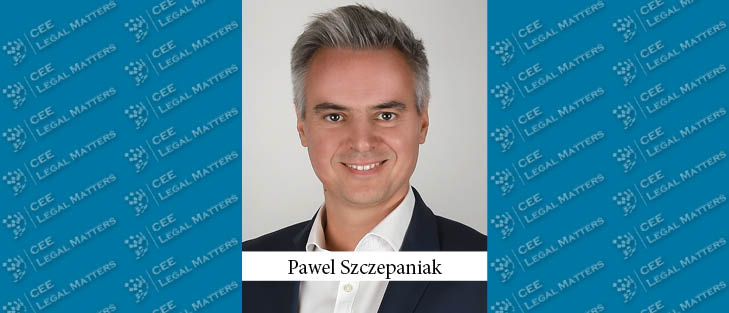mBank Deputy General Counsel Pawel Szczepaniak talks about how the rise of ESG has shaped in-house legal role but also how his organization literally puts its money where its mouth is when it comes to ESG.
CEELM: How has the rise of ESG impacted your organization as a whole to date?
Szczepaniak: In recent years, Environmental, Social, and Governance (ESG) factors have gained significant importance in corporate strategy and operations. Companies worldwide are recognizing the importance of sustainable and ethical practices not only to meet regulatory requirements but also to align with stakeholder expectations.
Throughout the last several years, the Polish banking sector proved to be particularly important in the context of financing the transformation of the whole economy into a more sustainable one. In 2023 alone, mBank’s offer related to the financing of renewable energy sources and investments in large RES plants made it possible to generate 641 megawatts of energy from renewable energy sources. At the end of December 2023, mBank’s RES portfolio reached almost PLN 4 billion. Furthermore, based on data from the end of 2023, we invested over PLN 5.3 billion of our own capital in sustainable finance initiatives. This includes sustainability-linked loans and green loans. We also acted as arranger/dealer of corporate bonds, facilitating the placement of our customers’ green bonds.
As one of the first Polish financial institutions, we also publish information on the carbon footprint of our portfolio (especially scope 3 – portfolio emissions). For that purpose, we use well-established, standardized international methodologies and, as part of our membership with the Science Based Targets initiative, we are developing an effective plan for decarbonizing our activities. Moreover, we were the first bank in Poland to join the Partnership for Carbon Accounting Financials.
However, ESG considerations are not only environmental challenges. There are also a number of examples of our social and employee-related activities. I will only mention the aspects that are important to us, such as improving the effectiveness of human rights verification in the group value chain and maintaining the pay gap below 5%. We are also consistently implementing social involvement programs, such as the Great Orchestra of Christmas Charity.
And, as part of our drive to promote ESG considerations in the financing world, we also introduced a new service line whereby we act as a so-called sustainability agent – an agent in syndicated SLL financing that verifies that the reporting of KPIs of our clients are in line with regulatory and documentary framework. It might seem like a small role but it is a significant one as it helps to set a market standard in the country.
Ultimately, a green transformation is reflected in mBank’s ESG strategy. It includes a decarbonization strategy based on SBTi objectives, which is our current priority in the area of sustainable development. mBank is a good example of the companies that successfully integrate ESG principles into their operations, which often allows them to enjoy a competitive advantage, attracting investment, talent, and customer loyalty.
CEELM: What about your in-house legal function – how has it been shaped by this focus on ESG?
Szczepaniak: The in-house legal function has been particularly affected by the rise of ESG. Traditionally focused on legal risk management and regulatory compliance, legal teams are now tasked with a broader mandate that includes advising on ESG-related issues. This shift has required legal departments to expand their focus beyond traditional legal risks to encompass environmental, social, and governance factors.
One significant impact on the legal function is the need to stay abreast of evolving regulations related to ESG. It is worth mentioning that currently there are over 600 ESG-related regulations in the regulatory database, and one-third of them are regulations from Europe. Legal teams must monitor changes in environmental laws, human rights regulations, labor practices, and corporate governance standards, all of which are increasingly being codified into law. This requires a deeper understanding of the ESG landscape and a proactive approach to compliance.
Additionally, the legal function is often called upon to advise on the development and implementation of ESG policies, strategies, and documentation standards. This involves working closely with other departments, such as sustainability, human resources, and corporate governance, as well as with other market participants and public sector representatives to ensure that the organization’s ESG initiatives are legally sound and align with best practices.
Furthermore, regulatory bodies are increasingly mandating ESG disclosures and compliance. This heightened regulatory scrutiny means that organizations must be proactive in their ESG strategies, ensuring that they not only meet legal requirements but also exceed them to safeguard against future risks.
CEELM: Is ESG compliance something you are looking to incorporate into your legal function? If so, how?
Szczepaniak: Incorporating ESG compliance into the in-house legal function is essential for organizations seeking to navigate the complexities of sustainable business practices. Legal teams play a pivotal role in ensuring that ESG principles are embedded into the organization’s operations and that compliance with ESG-related regulations is maintained.
To incorporate ESG compliance effectively, legal teams must first assess their current capabilities and identify any gaps in expertise or resources. This may involve conducting a thorough review of existing policies, procedures, and training programs to determine how well they align with ESG requirements.
Once gaps are identified, legal teams can take several steps to integrate ESG compliance into their functions. These steps may include:
1. Developing ESG Policies and Procedures: Legal teams can lead the development of comprehensive ESG policies that outline the organization’s commitment to sustainability, social responsibility, and ethical governance. These policies should be aligned with regulatory requirements and best practices and should be communicated clearly to all stakeholders.
2. Training and Education: Educating employees about ESG compliance is critical for fostering a culture of accountability. Legal teams can conduct training sessions to raise awareness about ESG regulations and ensure that employees understand their roles in achieving compliance.
3. Cross-Functional Collaboration: ESG compliance requires collaboration between legal, compliance, sustainability, and operational teams. Legal departments should work closely with other functions to integrate ESG considerations into business processes and decision-making.
CEELM: What new expertise does your team have to develop to incorporate all of this? Will you be looking to rely on internal resources or external expertise?
Szczepaniak: The rise of ESG necessitates the development of new expertise within the in-house legal function. Legal teams must be equipped to address both existing legal frameworks and emerging challenges related to ESG. At mBank we have ESG experts in every major legal support section, who lead workstreams within their respective product lines. There is one in the investment banking team, one in capital markets and M&A, one in the corporate clients’ department focusing on loan financing, one in retail, and another one in the brokerage house.
The required set of competencies entails, in particular:
Environmental Law Expertise: As environmental regulations become more stringent, legal teams need to deepen their knowledge of environmental law. This includes understanding regulations related to carbon emissions, waste management, and resource conservation, as well as staying informed about global environmental agreements and treaties.
Social Responsibility and Human Rights: Legal teams must also develop expertise in social responsibility and human rights issues. This includes understanding labor laws, diversity and inclusion requirements, and ethical labor practices. Legal professionals should be prepared to advise on policies that promote social equity and protect human rights.
Governance and Compliance: Governance is a critical aspect of ESG, and legal teams must be well-versed in corporate governance principles, compliance requirements, and risk management strategies. This includes understanding disclosure requirements, anti-bribery and corruption laws, and stakeholder engagement practices.
Organizations can choose to build this expertise internally by training existing legal staff or hiring new professionals with specialized ESG knowledge. Alternatively, they may choose to rely on external expertise, such as law firms or consultants with deep experience in ESG matters.
At mBank we chose a hybrid approach, combining internal development with external support, which in my opinion may offer the most flexibility and breadth of expertise. While we are very much focused on building up the necessary competencies internally, it is not sufficient given the depth of it all. We already have a panel of law firms in place focused on ESG as we’re bound to continue cooperating with external lawyers. We are also big on constant learning from the market – may it be in exchanging best practices with the Polish banking association and running or attending educational events with our clients. I see the latter as a mutual learning opportunity since we also get to learn from our clients in terms of what their expectations and the market standards are.
CEELM: What are currently the main unknown variables for your in-house legal function when it comes to ESG?
Szczepaniak: Several unknown variables present challenges for in-house legal teams when it comes to ESG.
Regulatory Uncertainty: The regulatory landscape for ESG is rapidly evolving, with new laws and regulations being introduced regularly. As I mentioned earlier, there are hundreds of regulations in the ESG area currently in place and many others are to come. Legal teams must stay vigilant in monitoring these changes and be prepared to adapt their strategies as new requirements emerge.
Variability in ESG Standards: There is currently a lack of uniformity in ESG standards and reporting frameworks. This variability can make it challenging for legal teams to ensure compliance across different jurisdictions and industries. Common standards are critical because, in lieu of them, banks need to rely on their own which ultimately means you might need to justify or defend them in front of a regulator down the line. That said, I do see a positive trend of aligning these standards. I see the unification exercise as an ongoing one and think most of the market is generally positive about its outlook.
Stakeholder Expectations: Stakeholders, including investors, customers, and employees, have varying expectations regarding ESG performance. Legal teams must navigate these expectations and advise on strategies that balance compliance with stakeholder demands.
To explore answers to these challenges, in-house legal teams can take several approaches. In my opinion, the most efficient solutions include continuous monitoring of regulatory developments, collaborating with external experts, engaging with stakeholders, and investing in training and education.
CEELM: How do you believe ESG will evolve going forward?
Szczepaniak: It is already noticeable that ESG will have a profound impact on the future of the in-house legal role. Legal teams will increasingly be viewed as strategic partners in shaping corporate ESG strategies and ensuring that organizations meet their sustainability goals. There will be a growing demand for legal professionals with expertise in ESG, and the skill set required for in-house legal roles will expand to include a deeper understanding of environmental science, social responsibility, and governance practices.
Key developments to watch include the ongoing evolution of ESG regulations, the rise of investor activism on ESG issues, advancements in technology for ESG compliance, and changing stakeholder expectations. By staying informed about these trends and proactively addressing ESG challenges, in-house legal teams can play a crucial role in driving sustainable business practices and safeguarding their organizations against legal and reputational risks.
I am convinced that effective sustainability management, such as shown in mBank’s example, is an expression of concern for the interests of the shareholders, customers, and the whole financial ecosystem. We will follow this path in line with our ESG strategy in the coming years.






















